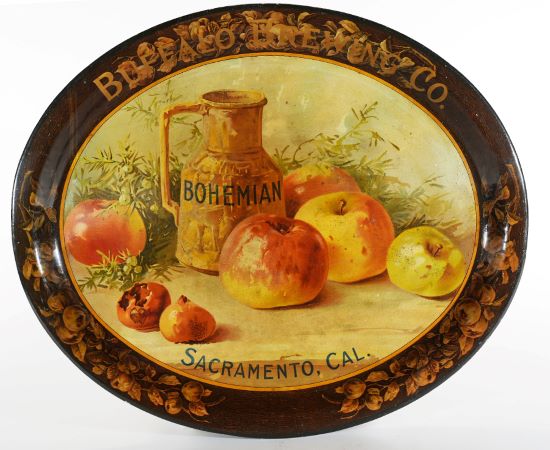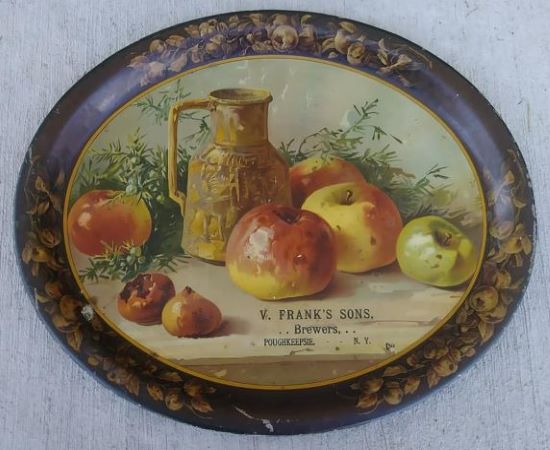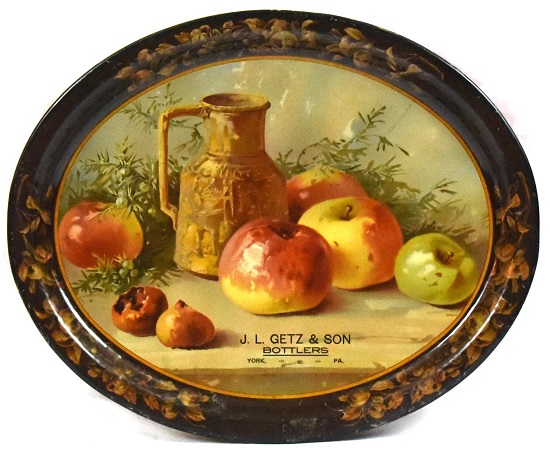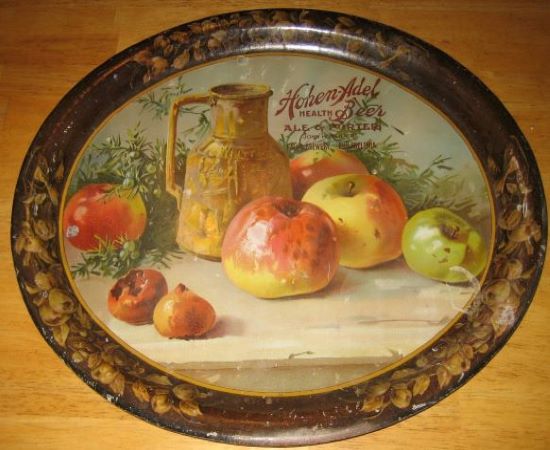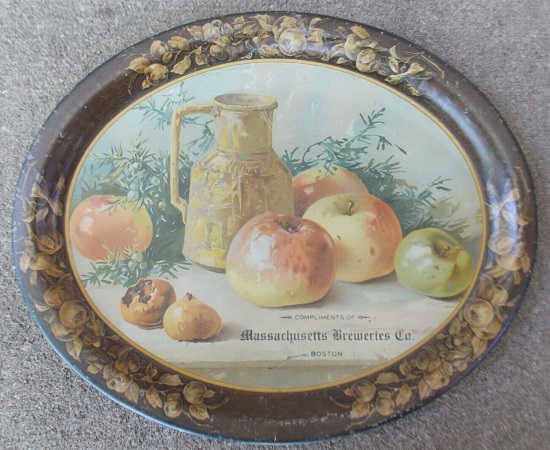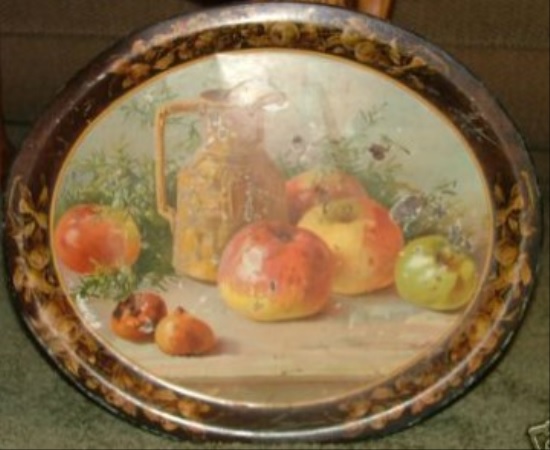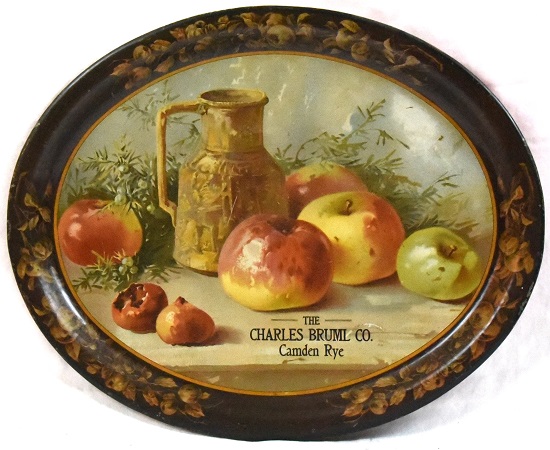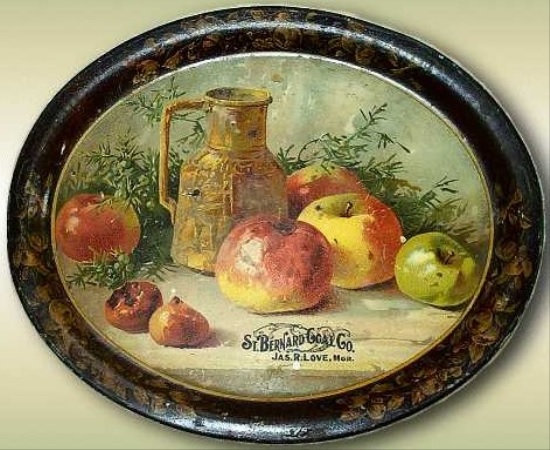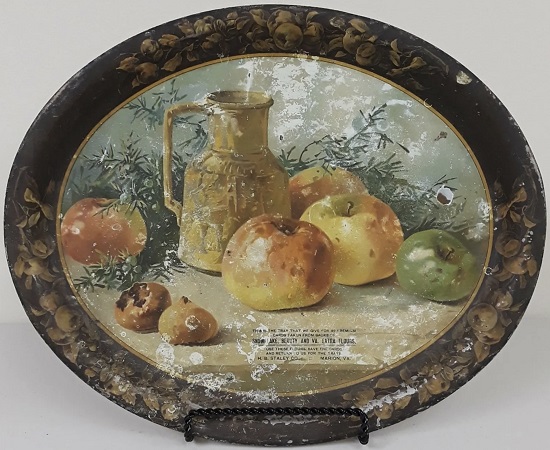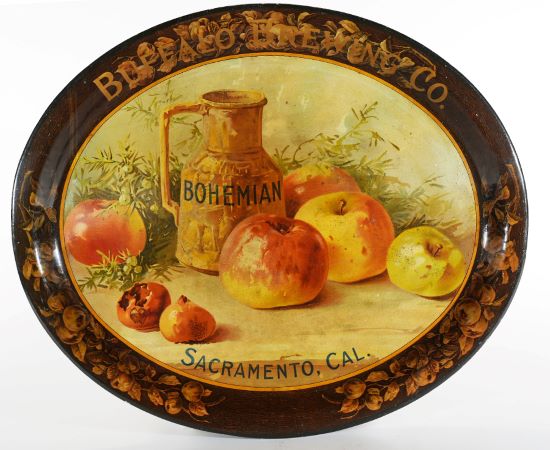The 'Stock' Exchange
H.D. Beach Co. No. 13-B - Jug & Apples Still Life
H.D. Beach Co. No. 13-B - Jug & Apples Still Life
Date: 1905 - 1910
Size: 16.5" x 13.5"
Type: Inverted Pie
Scarcity: Common
Value: $$$ to $$$$
Condition & Brewer Dependent
Size: 16.5" x 13.5"
Type: Inverted Pie
Scarcity: Common
Value: $$$ to $$$$
Condition & Brewer Dependent



Confirmed Brewer used Stock Trays
Non-Beer Related & Non-Tray Uses
General Comments
As previously noted in the discussion of Beach No. 10, the H.D. Beach company used more still-life designs than its major competitors. This design depicts a jug or pitcher, and fruit is more typical of Beach still-lifes than the vase and flowers in No. 10. The primary fruit depicted are apples; however, the fruits depicted in the lower left are clearly something else. Upon closer examination we believe these are persimmons.
As previously noted in the discussion of Beach No. 10, the H.D. Beach company used more still-life designs than its major competitors. This design depicts a jug or pitcher, and fruit is more typical of Beach still-lifes than the vase and flowers in No. 10. The primary fruit depicted are apples; however, the fruits depicted in the lower left are clearly something else. Upon closer examination we believe these are persimmons.
Click the Picture to Return to Meek & Beach Stock Catalog Page
Confirmed Brewer used Stock Trays
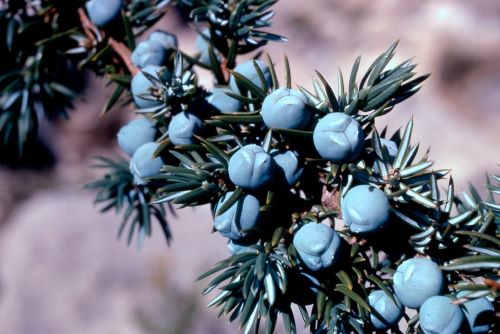
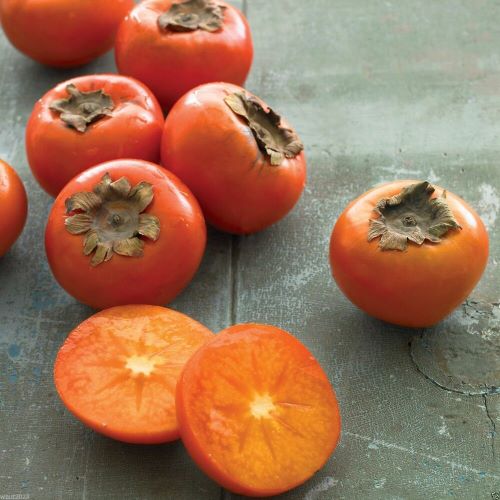
American persimmon is a woody, deciduous tree in the Ebenaceae (ebony) family. It is native to the central and eastern United States (from Florida to Connecticut, west to Iowa and south to Texas) and can reach 30 to 80 feet high and 20 to 35 feet wide.
Another name for the American persimmon is “sugar plum” (ever heard of the sugar plum fairy?). This name is very indicative of the qualities of the American persimmon; they are shockingly and wonderfully sweet, plus they’re about the size of a plum. As a result, eating just a few fruits can cause a sugar rush; however, unripe American persimmons are quite astringent, enough to make your mouth pucker quite uncomfortably.
These days you won’t find American persimmons in stores because they’re difficult to transport and do not keep well. We expect that in the early 20th century foraging was far more common and the general public was more familiar with this fruit than we are today.
Another name for the American persimmon is “sugar plum” (ever heard of the sugar plum fairy?). This name is very indicative of the qualities of the American persimmon; they are shockingly and wonderfully sweet, plus they’re about the size of a plum. As a result, eating just a few fruits can cause a sugar rush; however, unripe American persimmons are quite astringent, enough to make your mouth pucker quite uncomfortably.
These days you won’t find American persimmons in stores because they’re difficult to transport and do not keep well. We expect that in the early 20th century foraging was far more common and the general public was more familiar with this fruit than we are today.
The two other primary components in this composition are the pitcher or jug and the branches with pine or fur needles with greenish berries. The pitcher or jug has some texture to it suggesting some sort of design, but it is not distinct enough to identify it as any particular form or style.
The branches are something of a mystery to us; our best guess is that they are meant to be juniper; the berries are green when young and mature to a purple-black color over about 18 months in most species. Juniper berries are used in northern European and particularly Scandinavian cuisine to "impart a sharp, clear flavor" to meat dishes, especially wild birds and game meats (including boar and venison). They also season pork, cabbage, and sauerkraut dishes.
Like most early Beach trays this design does not have a formal title or artist attribution.
Size, Shape and Message Placement
Until recently we’d only ever seen this design as a standard full-sized oval serving tray. We then ran across a small, die cut tip tray version in a rectangle shape. To our knowledge, H.D. Beach was the only manufacturer to produce this style of simple (low cost) tip tray. It is also the only time we’ve seen a Beach stock design from a full-size tray on one of these type of tip trays. On the full-size version, rims are black with an overprinted gold branch and leaf design, which interfered with effective advertising text on the rim (see the Buffalo Brewing version as an example). More often, advertising text appears on the face of the tray in black text, although the Hohenadel example uses red. Printing on the back of the tray was also fairly common.
Size, Shape and Message Placement
Until recently we’d only ever seen this design as a standard full-sized oval serving tray. We then ran across a small, die cut tip tray version in a rectangle shape. To our knowledge, H.D. Beach was the only manufacturer to produce this style of simple (low cost) tip tray. It is also the only time we’ve seen a Beach stock design from a full-size tray on one of these type of tip trays. On the full-size version, rims are black with an overprinted gold branch and leaf design, which interfered with effective advertising text on the rim (see the Buffalo Brewing version as an example). More often, advertising text appears on the face of the tray in black text, although the Hohenadel example uses red. Printing on the back of the tray was also fairly common.
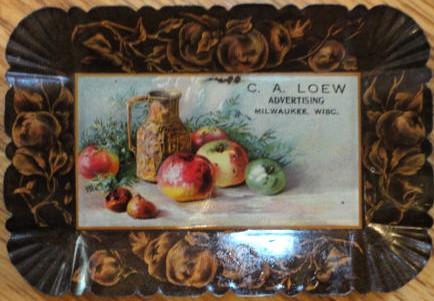
Hager & Price
There is no discussion in Hager regarding this tray, although it does appear in his catalog. Prices for this design tend to be fairly low (low to mid double figures), including off-grade examples from brewers. A very good example from Buffalo Brewing went for mid-three figures and we would expect other brewery examples in such condition to do equally as well.
There is no discussion in Hager regarding this tray, although it does appear in his catalog. Prices for this design tend to be fairly low (low to mid double figures), including off-grade examples from brewers. A very good example from Buffalo Brewing went for mid-three figures and we would expect other brewery examples in such condition to do equally as well.

